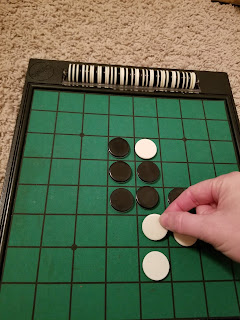Gameplay:
Each player starts with 32 discs and uses one color throughout the whole game.
Place two discs on the board as shown:
A move consists of "outflanking" your opponent's disc(s) and then flipping those discs to your color. "Outflank" means that you place a disc on the board so that your opponent's row(s) of disc(s) is/are bordered at each end by a disc of your color.
Here's an example: I place my black disc below the white disc so that I'm surrounding it, and then I get to flip it:
White is going to make a move similar to this on her next turn:
Now I need to capture another disc:
A few moves later, I can do this move and get two discs in two different directions:
But now white can make this move to capture three of my discs:
The game moves rather slowly at first, usually capturing one at a time for the first few moves. Don't worry - it ramps up, and you have to be very cautious in what move you decide to make!
Some Things to Remember:
Black always moves first.
If it's your turn and you can't outflank your opponent, skip your turn.
You can capture discs horizontally, vertically, or diagonally as long as they are in a continuous straight line.
How to Win:
Typically, once all 64 squares are covered, the game is over. Add up how many squares are covered by your color and the highest number wins. It is possible for a game to end before this, essentially in a stalemate, in which case you would still just add up your discs and count them as points.
Verdict:
Love! Love! Such a great game! This is a hit with everyone we've taught it to.
Great for Learning:
Strategy, patience (it's so similar to chess), critical thinking, thinking ahead to consequences of their moves






















































